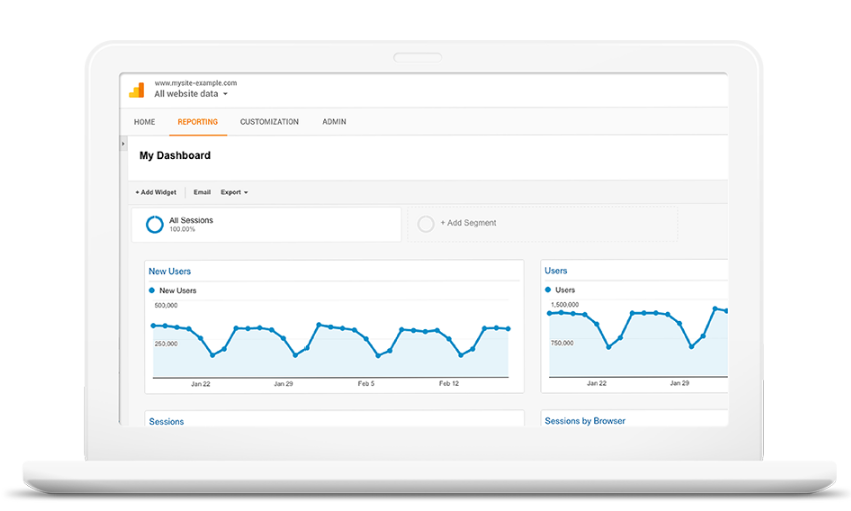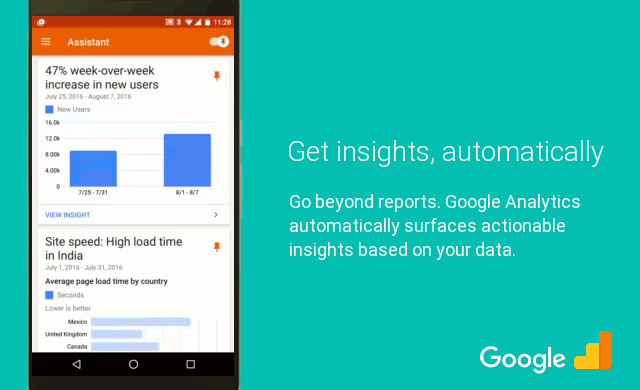
September 7, 2016: Last week, Google announced that it has added real-time, AI-enhanced reporting capabilities, as well as easier sharing of data, to its popular Analytics site analysis software. The new functionality, dubbed “Automated Insights,” is available on late-generation Andriod/IOS devices now; a web version is also in the works.
Why this is a big deal
“Google is taking the initiative and wants to let people know that it is going to be like a brain.” — Kevin Lee
Between 30 and 50 million marketers — at agencies, on the client side, or on their own doing businees as web-based entrepreneurs — use Google Analytics. According to W3Techs, GA powers analytics on 54.4 percent of all the sites on the web.
But while GA’s user base his huge, the actual range of tasks used by most users is quite narrow. Many — perhaps most — don’t need to dive too deeply into GA’s deep data stores to perform their jobs. As Didit’s Kevin Lee observes in a story in Advertising Age covering Google’s announcement,
I think what Google is realizing is people tend to exhibit the same behaviors when they pull reports from Analytics. Some people just want to see a geography or conversion report. They see people are exhibiting repeat behaviors and are streamlining the process for them. Google is taking the initiative and wants to let people know that it is going to be like a brain and put things in front of you… It can be like Amazon putting products you’ve previously bought in front of you when you visit their site.
Advanced GA users already know the value of Custom Reports, Intelligence Events, and Automated Alerts, which — when set up correctly — vastly improve the experience of using GA. By automating some of these processes, Google hopes to bring the same level of personalized sophistication to the marketing masses.
Immediate beneficiaries
In the blog article accompanying the launch of Automated Insights, Google specifically cited e-tailers as likely users of GA’s new capabilities.
During this busy time of the year, retailers face questions that can be the difference between making their numbers for the year or falling short: Which products are going to be popular this season? Where should we advertise? How are our customers hearing about us and purchasing from us? Answering just one of these questions and acting on that information can take analysts and marketers hours or even days.
Automated Insights is aimed at eliminating this “time to insight gap,” improving e-tailers’ ability to respond to fast-moving market conditions. This will allow allow budgets to be adjusted more quickly, product pages to be tuned to more closely align with instantaneous market demand, and content to be more accurately planned and generated to better serve rapidly-shifting consumer interest.
Data insights in Google Analytics automate the first steps of answering these questions by instantaneously surfacing opportunities and anomalies hiding in the data. For example, they can tell you which products are experiencing higher than normal sales growth, which advertising channels are driving the most conversions and the best returns, and on which devices customers engage with your brand. This moment-to-moment information gives retailers the power to make nimble, smart decisions that directly impact performance.

What’s next?
Google Analytics has become the industry standard in Web Analytics; its capabilities have grown by leaps and bounds since the software’s early, somewhat crude incarnation as Urchin. But many GA users — especially relative newbies to analytics — find GA’s user interface — which was obviously designed by engineers — intimidating. Consequently, the process of getting useful intel out of GA is — for many — more difficult than it should be. And while Custom Reports and Filters are the best line of defense against data overload in GA, not everyone uses them.
GA’s upgrade will definitely have a big impact on the way the millions of marketers use GA everyday. It “unsilos” the most important GA data by making it streamable and shareable. It will also change the nature of much digital marketing work as it’s performed today. As GA gets smarter, and eliminates the routine “digital drudgework” that consumes so many hours of so many analysts’ lives, a larger share of GA users will be able to focus on marketing — not reporting mechanics — a good thing for all concerned.
- 10 Mistakes to Avoid When Using QR Codes for Marketing - September 20, 2023
- Kevin Lee on How AI Changes the SEO Landscape - August 31, 2023
- The Power of Compound Marketing: Kevin Lee Presents @ 1MediaWorld 2023 Global Conference - March 7, 2023

